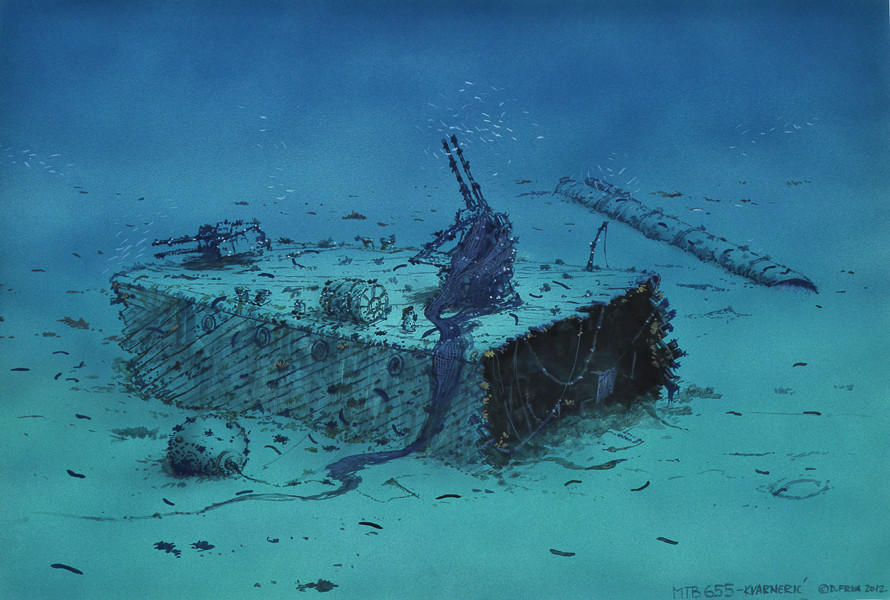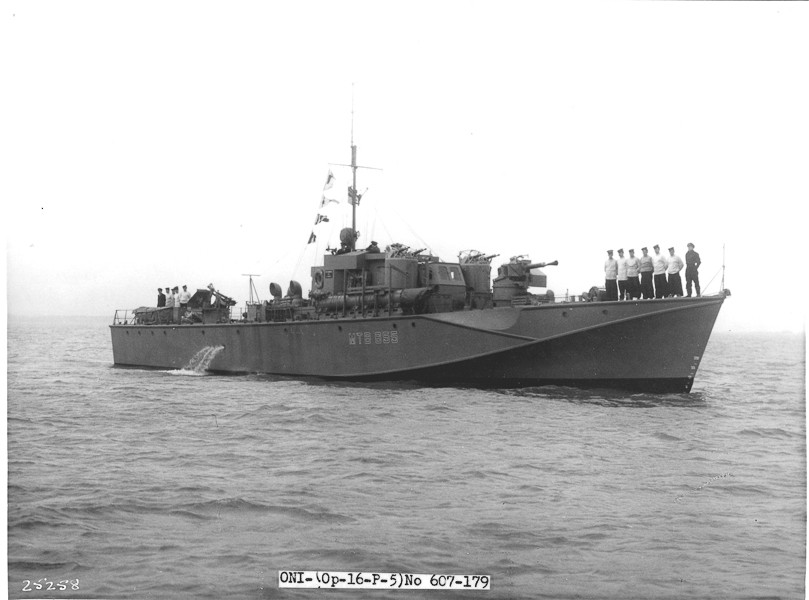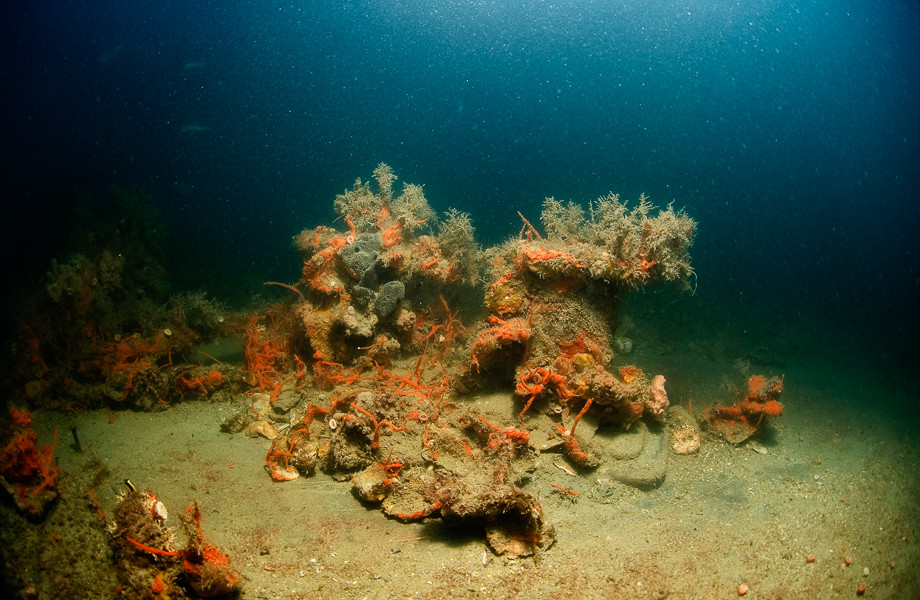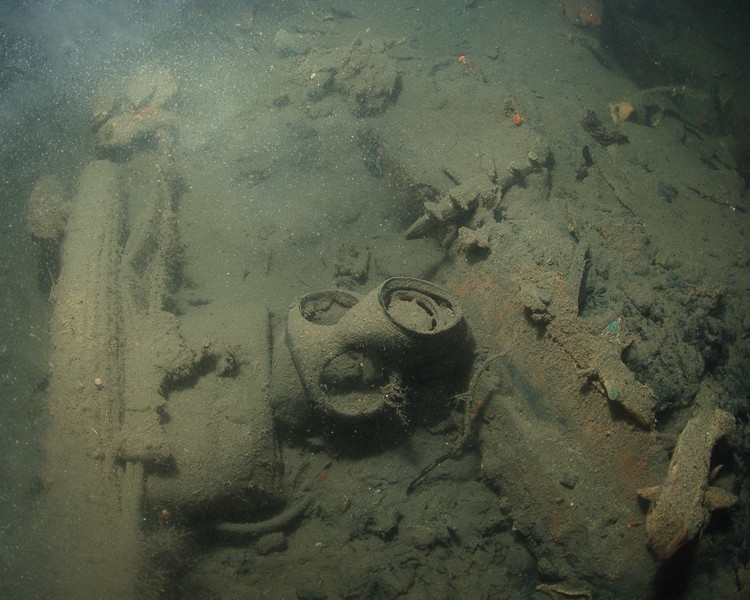
MTB 655
DEPTH: 49 - 52 m
SKILL: Expert
MTB 655; motor torpedo boat; British Royal Navy
Built: William Osbourne Ltd. shipyard, Littlehampton, Sussex, Great Britain, completed in January 1943
Sunk: 21st March 1945 (underwater mine)
Dimensions: l=35 m, w=6.5 m
Coordinates: 44.82277° N, 14.18500° E
Location: Kvarnerić
Access: 2/5 access is possible only by boat (location is in the open sea)
Visibility: 2/5 weak
Current: 3/5 average
Flora and fauna: 3/5 varied life on and around the wreck, sponges
HISTORY:
At the end of 1943, not a full two months after the capitulation of Italy, German forces captured the whole of the Adriatic coast except the islands of Vis and Lastovo. For the defence of the island of Vis, the Allies were constantly sending help for the Partisans such as food, clothes, footwear and medicine, so the defence of Vis was constantly being strengthened.
At the end of 1944 the German forces withdrew from southern and central Dalmatia, so the base of the British Costal Forces moved from Komiža north to the island of Ist and then to Zadar, from where the British torpedo boats and motorised gunboats attacked German ships more and more to the north, and by night even reaching up to the Bay of Trieste.
On one such mission, three torpedo boats set sail from Zadar on the evening of 21st March 1945, on a patrol route towards the eastern coast of Istria. During the night they hadn’t encountered any enemy ships and so in an early morning hours they started their way back towards Zadar so that they would not be surprised by German aircraft in the morning. They sailed a route which they believed was safe from mines, their greatest underwater enemy. The Germans had, in fact, laid several thousand mines in the Northern Adriatic so as to block the approach to Kvarner and the harbours on the Istrian peninsula, however the Allies through their Partisan connections, had obtained a map which charted the minefields. When the frontline moved towards the north, at the beginning of 1945, the Germans blocked the region of Kvarnerić with additional minefields, about which the Allies had no information.
During the journey, a tremendous explosion suddenly erupted, from which the whole central part of the ship was lifted into the air. When the smoke from the explosion had cleared, the fore and aft parts of the boat were still floating on the surface, whilst the fuel from the broken tanks had spread onto the surface of the sea and immediately caught fire. The remains of the torpedo boat quickly sank, whilst the majority of the crew was saved by the other boats, however seven members of the crew were nowhere to be found.
WRECK CONDITION AND DIVING:
Location of the wreck is right in the middle of Kvarnerić, approximately halfway between Ližnjan in Istria and the cove of Martinšćica on Cres. Its depth is 52 metres, the wreck rises just a few metres above the sea bottom so it can located only by a good graphic echo sounder. The main sections of the wreck are spaced at fifty metres apart and so to tour the two largest sections two dives need to be planned.
The sea is usually clear at a shallow depth, however at some forty metres the visibility usually reduces sharply, and at the bottom it becomes only a few metres. Thick shoals of thousands of tiny fish envelope the wreck and only disperse when we approach much closer. Attached to the deck with its barrels pointing towards the surface, stands a gun which is immediately noticeable. This is a 20 mm calibre Oerlikon type gun intended for anti-aircraft combat, which was situated on the stern deck. The deck is wooden, composed of obliquely connected strip-like planks similar to a parquet floor and yet despite time it is still quite well-preserved. At the section where hull is ruptured, there is a large dark gaping hole. The interior can be accessed with care, but a good torch is necessary. In the beam of light, torn wires and tubes which hang from the ceiling will appear. Slowly and steadily, floating above the bottom without using flippers so as not to disturb the fine silt, and only using hands as guides, the interior can be entered. At the sea bottom, half buried in the silt, a rubber gas mask is visible and a little bit further along a sailor's boot and various other objects. In the half-light, a ceramic toilet can be discerned and from the silt various other small objects protrude.
Leaving the interior we can pass along the side on which a row of windows with glass is clearly visible, and then looking to the opposite side, where not far away from the hull a torpedo tube lies on the bottom. By its shape and particular appearance, with its bevelled front, it can be seen that it belongs to a British motor torpedo boat. A torpedo is still in the tube and its warhead can be seen from the front.
Note: The locality is protected. Diving is allowed only through authorised diving centres, of which there are several nearby.
The description and illustrations are a courtesy of Danijel Frka and Jasen Mesić. Buy the whole book here: https://shop.naklada-val.hr/product_info.php?products_id=561
Built: William Osbourne Ltd. shipyard, Littlehampton, Sussex, Great Britain, completed in January 1943
Sunk: 21st March 1945 (underwater mine)
Dimensions: l=35 m, w=6.5 m
Coordinates: 44.82277° N, 14.18500° E
Location: Kvarnerić
Access: 2/5 access is possible only by boat (location is in the open sea)
Visibility: 2/5 weak
Current: 3/5 average
Flora and fauna: 3/5 varied life on and around the wreck, sponges
HISTORY:
At the end of 1943, not a full two months after the capitulation of Italy, German forces captured the whole of the Adriatic coast except the islands of Vis and Lastovo. For the defence of the island of Vis, the Allies were constantly sending help for the Partisans such as food, clothes, footwear and medicine, so the defence of Vis was constantly being strengthened.
At the end of 1944 the German forces withdrew from southern and central Dalmatia, so the base of the British Costal Forces moved from Komiža north to the island of Ist and then to Zadar, from where the British torpedo boats and motorised gunboats attacked German ships more and more to the north, and by night even reaching up to the Bay of Trieste.
On one such mission, three torpedo boats set sail from Zadar on the evening of 21st March 1945, on a patrol route towards the eastern coast of Istria. During the night they hadn’t encountered any enemy ships and so in an early morning hours they started their way back towards Zadar so that they would not be surprised by German aircraft in the morning. They sailed a route which they believed was safe from mines, their greatest underwater enemy. The Germans had, in fact, laid several thousand mines in the Northern Adriatic so as to block the approach to Kvarner and the harbours on the Istrian peninsula, however the Allies through their Partisan connections, had obtained a map which charted the minefields. When the frontline moved towards the north, at the beginning of 1945, the Germans blocked the region of Kvarnerić with additional minefields, about which the Allies had no information.
During the journey, a tremendous explosion suddenly erupted, from which the whole central part of the ship was lifted into the air. When the smoke from the explosion had cleared, the fore and aft parts of the boat were still floating on the surface, whilst the fuel from the broken tanks had spread onto the surface of the sea and immediately caught fire. The remains of the torpedo boat quickly sank, whilst the majority of the crew was saved by the other boats, however seven members of the crew were nowhere to be found.
WRECK CONDITION AND DIVING:
Location of the wreck is right in the middle of Kvarnerić, approximately halfway between Ližnjan in Istria and the cove of Martinšćica on Cres. Its depth is 52 metres, the wreck rises just a few metres above the sea bottom so it can located only by a good graphic echo sounder. The main sections of the wreck are spaced at fifty metres apart and so to tour the two largest sections two dives need to be planned.
The sea is usually clear at a shallow depth, however at some forty metres the visibility usually reduces sharply, and at the bottom it becomes only a few metres. Thick shoals of thousands of tiny fish envelope the wreck and only disperse when we approach much closer. Attached to the deck with its barrels pointing towards the surface, stands a gun which is immediately noticeable. This is a 20 mm calibre Oerlikon type gun intended for anti-aircraft combat, which was situated on the stern deck. The deck is wooden, composed of obliquely connected strip-like planks similar to a parquet floor and yet despite time it is still quite well-preserved. At the section where hull is ruptured, there is a large dark gaping hole. The interior can be accessed with care, but a good torch is necessary. In the beam of light, torn wires and tubes which hang from the ceiling will appear. Slowly and steadily, floating above the bottom without using flippers so as not to disturb the fine silt, and only using hands as guides, the interior can be entered. At the sea bottom, half buried in the silt, a rubber gas mask is visible and a little bit further along a sailor's boot and various other objects. In the half-light, a ceramic toilet can be discerned and from the silt various other small objects protrude.
Leaving the interior we can pass along the side on which a row of windows with glass is clearly visible, and then looking to the opposite side, where not far away from the hull a torpedo tube lies on the bottom. By its shape and particular appearance, with its bevelled front, it can be seen that it belongs to a British motor torpedo boat. A torpedo is still in the tube and its warhead can be seen from the front.
Note: The locality is protected. Diving is allowed only through authorised diving centres, of which there are several nearby.
The description and illustrations are a courtesy of Danijel Frka and Jasen Mesić. Buy the whole book here: https://shop.naklada-val.hr/product_info.php?products_id=561








 The investment is co-financed by the Republic of Slovenia and the European Union from the European Regional Development Fund.
The investment is co-financed by the Republic of Slovenia and the European Union from the European Regional Development Fund.  H2O Globe BETA
H2O Globe BETA